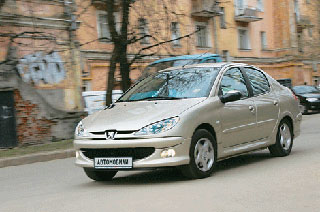PEUGEOT 206 Sedan West Drive Sedan
Second-Hand-Peugeot 206 from $ 8,000

Peugeot 206 replaced the famous 205th at the very end of 1998 and almost immediately began to climb up in sales ratings. Still, such a beautiful and so inexpensive car. But there are no miracles in the world, and something always has to be sacrificed.
The car is really beautiful, besides, like all Peugeot, it has good running qualities and excellent handling, in general, the design does not have any frank miscalculations or weaknesses. However, the quality of the assembly and components was partly a victim of savings.
Engines
The 206th was equipped with four gasoline and three diesel engines. All gasoline engines are 4 -cylinder with a working volume of 1.1, 1.4, 1.6 and 2 liters (installed on sports modification S16). The smallest engine, of course, is intended simply for moving from point A to point B, it is unlikely to be pleased with any decent dynamics. The next engine - with a volume of 1.4 liters - is no longer so sluggish and allows you to feel quite confident in the traffic flow. True, if you hang an automatic box and air conditioning on it, the strength of the motor becomes not enough. The 1.6 liter engine with such a small and light machine copes in any conditions, and the 2 -liter modification is already for fans to squeeze. There are practically no serious complaints about the motors, except that small oil leaks often appear at various seals, which is not a serious problem. Since the end of 1999, the frequency of engines maintenance has changed. Until that time, the intervals between which were 15 thousand and 10 thousand km for normal and difficult operating conditions, respectively, and then the frequency was increased to 30 thousand and 20 thousand km, respectively. The frequency of replacement of the timing belt for gasoline engines is 90 thousand and 80 thousand km, respectively, the cost of this operation is $ 120.
The gamut of diesel engines includes a 1.4 liter turbodiesel, which does not deliver to our market, and it is very unlikely to meet it here, perfectly proven atmospheric diesel diesel engine and a 2-liter turbocharged HDI equipped with a Common Rail system. With a 2-liter motor, HDI Peugeot 206 acquires truly sports dynamic indicators, while thanks to less extreme suspension settings compared to version S16, it is easier and more comfortable to control such a machine. Peugeot diesel engines, according to experts, are one of the best in the world, which is fully true. The only claim to them is almost constant small smudges of oils on seals. Trying to ensure that the motor is dry, is useless, you just need to come to terms with this. For HDI, the quality of diesel fuel is also important, otherwise you can kill rather expensive fuel equipment.
The frequency of then for a 1.9 -liter engine is 15 thousand or 10 thousand km, depending on the operating conditions, and for 2.0 HDI - 20 thousand or 15 thousand km. The replacement of the timing belt is provided after 90 thousand or 80 thousand km. The cost of this operation is $ 200 for version 1.9 and 180 dollars for version 2.0. When buying a used car, a belt, as well as oil with all filters, is better to change immediately. On each it is also necessary to drain from the fuel filter. It is better to use oil recommended by the manufacturer - synthetic Total 5W40. The replacement of the coolant is provided every 2 years or 120 thousand km of run.
Transmission
There are no complaints about the reliability of the transmission. In mechanical gearboxes, gear shifts are not as clear as on most German machines, but these are design features. Automatic AL4 boxes were installed only with 1.4 liter gasoline motors. It produces these nodes a joint venture, which also supplies them to Citroen and Renault plants. The guaranteed resource of automatic machines is 120 thousand km (for comparison: in ZF this value reaches 250 thousand km), so buying a used 206 with a machine gun is only carefully weighing all the pros and cons and only after careful diagnosis of specialists. There are frequent cases of oil leakage along the seals of drives. Oil replacements or automatic machines do not require, only periodic control of its level. But the oil replacement immediately after buying a car will still benefit. Oil in the boxes you need a special - Total production. Circules and drive shafts do not create problems if you monitor the condition of the anthers and change them in time. The clutch resource will depend on the driving manner, so it is difficult to call some guidelines here.
Suspension and steering
The front suspension design is very simple, so there can be no big problems with it, in principle. Ahead most often after 30-50 thousand km. Stabilizer's thrust fail. This part is inexpensive ($ 25), it changes simply. Ball supports change along with levers ($ 120 per one), their resource is approximately 60 thousand km and depends primarily on the driving manner and operating conditions. A rare case when the manufacturer supplies separately the anthers of the ball supports, but for the 206th this option is provided, so if you notice the torn anthers in time, it can simply be replaced with a new one and avoid replacing the lever. Shock absorbers, both front and rear, withstand more than 100 thousand km, it is better to change them to the original ones, the production of Peugeot, which are not much more expensive than non -original, but their resource is much higher, because Peugeot is one of the few automobile companies that produces shock absorbers herself. The cost of shock absorbers is 65 dollars for the front, $ 60 per rear. The collapse of the front wheels is not regulated, therefore, if during the purchase the inconsistency of this parameter by factory data is found, the body is most likely deformed.
The rear suspension is traditional for Peugeot - a beam with torsiones. After about 100 thousand km of run, it is advisable to change the beams of the beam ($ 250) in order to further avoid the breakdown of the beam itself and its expensive replacement. It is also necessary to monitor the pillows through which the beam is attached to the body. But these details, if not to kill them intentionally, withstand the mileage of more than 100 thousand km. Replacing them costs $ 80.
There are no complaints on the steering. According to a version with a 1.1 liter engine, the steering was installed with both the and without amplifier, on other versions, the amplifier is included in the list of basic equipment. Only steering tips ($ 40 per one) require periodic replacement.
Brake system
Front brake pads serve 20-30 thousand km, the cost of the kit is 00 dollars. Brake discs will require replacement after about 100 thousand km, the cost of each - $ 45. The back, as a rule, are drum brakes that do not cause special trouble. Periodic adjustment requires a parking brake, this operation is included in the standard large that. The brake fluid is replaced every 2 years or 60 thousand km of run.
Body and electrical equipment
It is they who cause the majority of the complaints of the owners. There are no problems with corrosion resistance of the body, unless, of course, the car fell into an accident. But the quality of the salon panels leaves much to be desired. This salon will never be quiet, very inexpensive materials were used in its production. In addition, many owners have quite reasonable claims to weak sound insulation of the salon, on many versions the material of the steering wheel is not too pleasant to the touch. What to do, but the price of the car is low.
Electrical equipment also causes complaints, and there is a very definite reason. Peugeot does not use the services of one of the best manufacturers of electric components - the German company VDO, preferring less expensive suppliers represented by Valeo, Magnetti Marelli, AMC. And the reliability of their products is lower, therefore, periodically, all sorts of small and not very small malfunctions arise: the central locking does not want to work, then the airbag lights light up, then water gets into the rear lights, the engine loses its power due to problems in the control electronics. Electric windows of doors do not always work well and quietly, belts scream, sometimes some more electrical problems arise. This is not to say that these malfunctions are of a general in nature and that all 206s only do what they are on services, but nevertheless. And in such cases, the qualifications of personnel who are engaged in the search and elimination of all these minor shortcomings come to the fore. If only one method of repairing electrical equipment is known on the service-the replacement of the nodes, the 206th can easily become a gold car, although the problem often comes down to unreliable contact somewhere in an electrocope.
Maintenance
For the 206th, two types of then - A and C. The first of them are small, it mainly boils down to the replacement of oil and filters, as well as checking the levels of technical fluids and other control operations. The second is much larger in volume and, in addition to operations provided for in a small thing, includes a number of adjusting work and in -depth control of the technical condition of the car. For machines with gasoline engines, small and large are performed alternately, and for diesel - two small, then one large. When planning the frequency of then, you should not deceive yourself for large intervals, because if you look at what operating conditions are considered difficult, it turns out that the usual ride on our roads, especially in the city, in all respects is suitable for determining difficult operating conditions. Therefore, even then it must be carried out more often.
conclusions
They are obvious. When purchasing an inexpensive car, we must be aware that everything in it cannot be perfect. If you like the appearance of Peugeot 206, if you value handling in the car and are ready to put up with the creaks in the cabin, periodically arising problems with electrical equipment (if you are lucky, it will do without them), in principle, there are no special objections to the acquisition of this French beauty . When buying, you should pay attention to the condition of the body, check its geometry at a good stand, see that there are no malfunctions with electrical equipment, because if the car is sold with them, most likely, to cure these malfunctions is either not easy or expensive.
When repairing spare parts, it is advisable to know not only the body number located under the windshield near the left rack, but also the so -called production number, which is indicated on the tag, pushed into the opening of the left front door on the middle counter of the body. As already mentioned, Peugeot has several suppliers of components, and by the production number it is possible to determine which manufacturer’s details are on a particular car.
As for the prices for used Peugeot 206, the 3-year-old car in Moscow costs from $ 8,000 to $ 10,000.
Some technical characteristics of Peugeot 206 1.6
(manufacturer data)
Dimensions, mm: 3835x1650x1430
Working engine volume, cubic meter. See: 1587
Max. Power, L.S./rpm: 109/5750
Max. moment, nm/rpm: 147/4000
Max. Speed, km/h: 200
Acceleration time 0-100 km/h, s: 9.9
Fuel consumption, l/100 km city/highway: 9.2/5.6
Leonid Klimanovich
Source: Avtopanorama magazine








